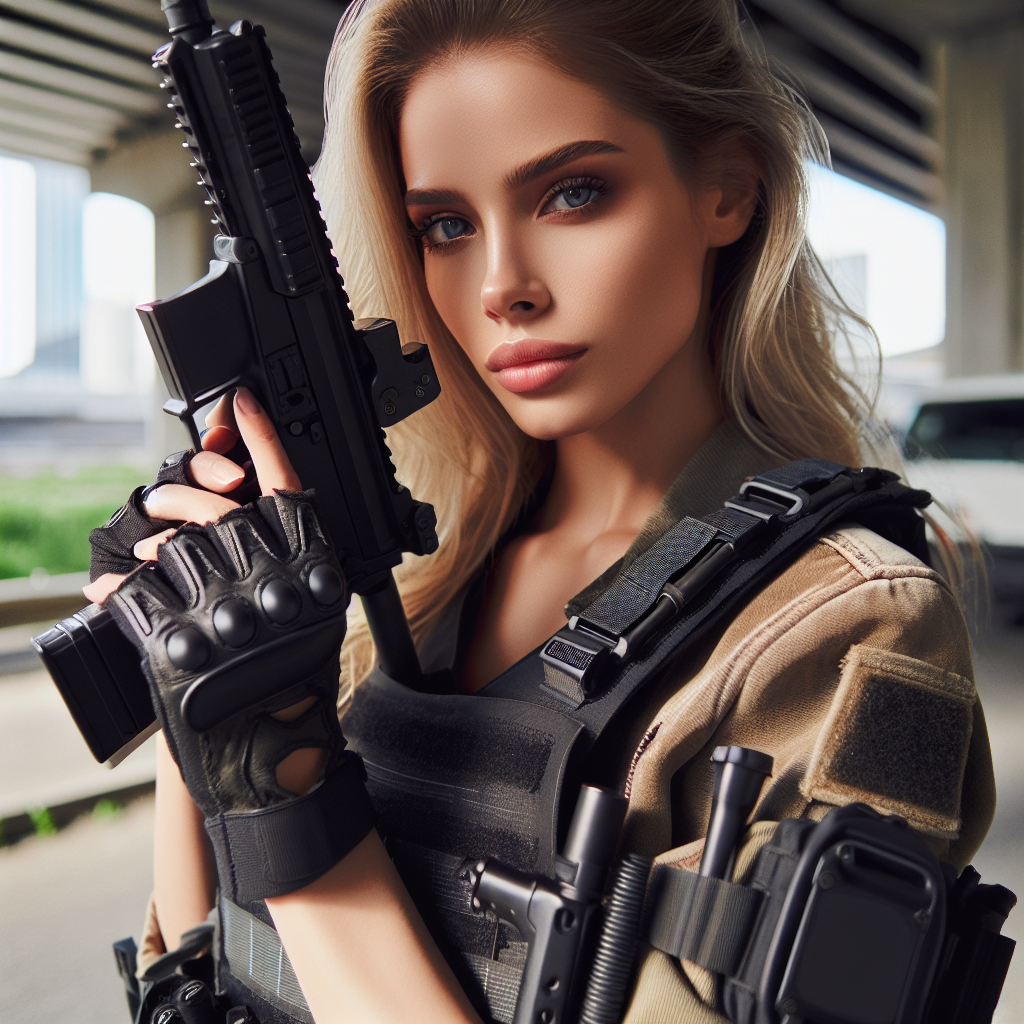Womens Firearms
Top 10 Must-Have Gun Safety Essentials for Women

Hello, ladies! My name is Jade Tripp and I am here to share with you the top 10 must-have gun safety essentials for women. As an expert in women’s self-defense and firearms, I believe that being prepared and staying safe is crucial in today’s world.
1. Gun Safe: Investing in a high-quality gun safe is essential to keeping your firearms secure and out of reach from unauthorized users. Look for a safe that is heavy-duty and tamper-proof, with a reliable locking mechanism.
2. Trigger Lock: A trigger lock is a simple yet effective way to prevent accidental discharges. Make sure to use a lock that fits securely around your gun’s trigger to prevent any mishaps.
3. Gun Holster: A good gun holster is essential for carrying your firearm safely and comfortably. Look for one that is durable and fits your body type, ensuring easy access to your weapon when needed.
4. Gun Cleaning Kit: Proper maintenance of your firearm is crucial for its longevity and performance. Invest in a gun cleaning kit with all the necessary tools and solvents to keep your firearm in top condition.
5. Eye and Ear Protection: When shooting at the range or in a self-defense situation, protecting your eyes and ears is vital. Invest in a pair of high-quality ear muffs and shooting glasses to safeguard your senses.
6. Training Courses: No matter how experienced you are with firearms, ongoing training is essential for improving your skills and knowledge. Take advantage of women’s self-defense and firearms training courses to stay sharp and confident.
7. Self-Defense Tools: In addition to your firearm, it’s important to have other self-defense tools at your disposal. Consider carrying pepper spray, a stun gun, or a personal alarm for added protection.
8. Gun Lock Box: If you need to travel with your firearm or store it in your vehicle, a gun lock box is a secure way to transport and store your weapon. Look for a lock box that is durable and tamper-resistant.
9. Emergency Contact List: Keep a list of emergency contacts, including local law enforcement and trusted friends or family members, in case of any emergencies involving your firearm.
10. Practice and Stay Informed: Stay informed on the latest gun laws and regulations in your area, and regularly practice shooting drills to maintain your skills. Knowledge is power, so make sure to stay up-to-date on all things related to gun safety.
Remember, safety should always be your top priority when handling firearms. By investing in these top 10 gun safety essentials for women, you can take proactive steps towards protecting yourself and your loved ones. Stay safe, stay prepared, and stay empowered!
Womens Firearms
The Psychology of Home Invasions: Understanding the Mind of an Intruder

Hello, ladies! I’m Jade Tripp, and today I want to dive into a topic that not only enforces the importance of self-defense but also arms us with knowledge—knowledge that can empower us to protect ourselves and our homes. Understanding the psychology behind home invasions is crucial for identifying potential threats and responding effectively.
The Intruder’s Mindset
To comprehend the psychological profile of an intruder, we first need to acknowledge that most home invasions are crimes of opportunity. The intruder often looks for easy targets—homes that present minimal risk and maximum reward. This could include:
- Visible signs of vulnerability: Unlocked doors, windows left open, or even cluttered pathways that suggest no one is home can all serve as invitations for an intruder.
- Routine observation: Many intruders will scout neighborhoods to note residents’ schedules and habits. If they see you consistently leaving for work at the same time, they might choose that moment to strike.
Real-Life Example: A Neighbor’s Story
Take the story of Sarah, a single mom living in a quiet suburb. She often left her back door unlocked during the day while playing with her children in the front yard. An intruder, having observed her routine, took advantage of this vulnerability one afternoon. Thankfully, Sarah was alerted by her barking dog and was able to scare the intruder off. This experience has allowed Sarah to become an advocate for home safety in her community, encouraging other women to never underestimate the significance of securing their homes.
Understanding Their Motives
Most home invaders are not only after valuables but also possess a psychological profile that can vary widely. Some common motives include:
-
Financial Gain: This is the primary motivation behind most break-ins. Intruders will look for cash, jewelry, electronics, or even prescription drugs.
-
Dare or Thrill-Seekers: Some invaders may be motivated by the adrenaline rush rather than monetary gain. The "game" aspect of breaking into homes can sometimes be appealing to certain individuals.
- Targeted Individuals: Occasionally, intruders may have a personal vendetta. This could be against a former partner or someone they feel has wronged them, making it essential to recognize warning signs in personal relationships.
A Notable Case: The Impact of Personal History
Consider the infamous case of the “North Carolina Burglar,” who was eventually caught due to his personal history of family disputes and targeted attacks. His story reminds us that intruders may have deeper psychological issues stemming from their past, which can lead them to commit such acts. It emphasizes the importance of knowing your surroundings and being aware of any potential threats.
Prevention Tactics
Understanding an intruder’s mindset can help us take crucial preventive measures. Here are a few strategies that can make your home less appealing to potential intruders:
-
Secure All Entry Points: Install deadbolts and security systems. Simple things like window locks and door security bars can deter unwanted visitors.
-
Create Illusion of Occupancy: Utilize timers on lights, or have neighbors keep an eye on your home when you’re out, making it look like someone is home.
-
Build a Community: Get to know your neighbors. A close-knit community can serve as an excellent deterrent as people look out for one another.
- Self-Defense Training: Knowing how to defend yourself gives you confidence and prepares you for the worst-case scenario. Organizations like the Rape Aggression Defense (RAD) program offer valuable courses specifically designed for women.
Sharing Strength
Remember, ladies, it’s essential to discuss these topics not just in private settings but also openly in community forums and workshops. Sharing stories and insights helps create awareness and fosters a strong sense of community support. Just like Sarah did—her experience turned into a powerful lesson for many, encouraging self-defense workshops and neighborhood watch groups.
Conclusion
Understanding the psychology of home invasions can equip us with the tools and knowledge needed to safeguard ourselves and our loved ones. It’s crucial to take proactive steps to fortify our homes, but even more important is the mindset we cultivate as women. Remember, you are not alone in this, and together, we can create a safe environment for ourselves and our communities.
Stay empowered, stay informed, and let’s keep the conversation going. Until next time, take care of yourselves and each other!
Warmly,
Jade Tripp
Womens Firearms
"Understanding the Laws: Concealed Handgun Permit Requirements"

Hello, ladies! It’s Jade Tripp here, and today we’re diving into a vital topic for any woman considering self-defense options: understanding the laws surrounding concealed handgun permit requirements. Knowing the ins and outs of these laws is empowering, and it equips us with the knowledge we need to take charge of our safety.
Why It Matters
Before we get into the specifics, let’s acknowledge why understanding these laws is crucial. As women, it’s important to feel secure in your environment, whether you’re heading home late from work, out jogging in your neighborhood, or simply running errands. Owning a firearm for protection can be a viable option, but only if you do it legally and responsibly.
The Legal Landscape
Concealed carry laws vary significantly from state to state, so it’s vital to understand the regulations in your specific location. Let’s break this down:
1. Eligibility Requirements
Most states have eligibility requirements for obtaining a concealed handgun permit (CHP). Common criteria include:
- Age: Generally, you must be at least 21 years old.
- Residency: Many states require you to be a resident of that state. For example, California mandates an applicant to be a resident of the county in which they apply.
- Background Check: Many states perform a criminal background check to ensure applicants do not have felony convictions or documented mental health issues.
Example: In Ohio, you must complete a background check and also have no major criminal charges within the past several years.
2. Training Requirements
Most states require some form of training or education. This can vary from basic firearm safety courses to more intensive self-defense training.
- Training Courses: Look for state-approved training facilities. In Texas, for example, you need to complete a four to six-hour training course followed by a shooting proficiency demonstration.
Example: Many women find empowerment in taking women’s self-defense courses which not only teach you how to handle a firearm but also provide practical self-defense strategies.
3. Application Process
The process can include filling out forms, submitting proof of training, and paying a fee.
- Documentation: You may need to provide identification, training certificates, and sometimes, proof of residency.
In Florida, the process is fairly streamlined; you submit an application, fingerprint your documents, and wait for approval, which can take anywhere from a few weeks to a few months.
4. Permits and Renewal
Once you have your permit, be aware of its validity and the process for renewal. Most states require periodic renewal every few years, which may involve a refresher course or re-application.
Example: In Illinois, concealed carry permits are valid for five years before they need to be renewed, and renewal requires completing training similar to the original training.
5. Where You Can Carry
Understanding where you can legally carry your concealed firearm is crucial. Some places may have restrictions, including government buildings, schools, and establishments that serve alcohol.
Example: In many states, you cannot carry in schools or on public transportation. It’s essential to be familiar with your state’s specific regulations to avoid accidental legal infractions.
Final Thoughts
I encourage every woman out there to educate themselves on these requirements, join a local self-defense class, and talk with other women in your community who may have gone through this process.
Empower Yourself!
Remember, the goal is not just to carry, but to feel empowered and equipped to protect yourself. Surrounding yourself with female instructors or finding a supportive community can make a world of difference. Organizations like The Well Armed Woman and A Girl & A Gun provide resources, camaraderie, and education.
By understanding the laws and taking the necessary steps, you are part of a growing movement of empowered women exercising their rights to self-defense. Stay safe, stay informed, and most importantly, stay confident!
Let’s take control of our safety together! Happy protecting! 🛡️💪
Womens Firearms
Women of India Demand Firearms: Addressing Safety Concerns

In response to inadequate police protection, Indian women are rallying for their right to bear arms. We explore the implications of …
source
-

 Womens Self Defense11 months ago
Womens Self Defense11 months agoNew Legislation Empowers Women to Defend Themselves
-

 Self Defense News1 year ago
Self Defense News1 year agoShe was convicted of killing her abusive boyfriend. Now a Maple Grove woman is home awaiting a new trial.
-

 Self Defense News1 year ago
Self Defense News1 year agoSelf-Defense for All: The new Gracie Jiu-Jitsu Pasadena is for everyone | Online Features
-

 Womens Self Defense1 year ago
Womens Self Defense1 year agoTop 5 Self-Defense Techniques Every Woman Should Know
-

 Womens Self Defense7 months ago
Womens Self Defense7 months agoUnderstanding State-by-State Variation in Self Defense Laws
-

 Womens Fitness1 year ago
Womens Fitness1 year agoXtreme Bodyweight HIIT (Lots of Jumping!) | Joanna Soh (Fio Series)
-

 Womens Preparedness1 year ago
Womens Preparedness1 year ago10 essential skills for surviving in the great outdoors
-

 Womens Preparedness1 year ago
Womens Preparedness1 year agoEmpower Yourself: A Guide to Female Survival Planning



